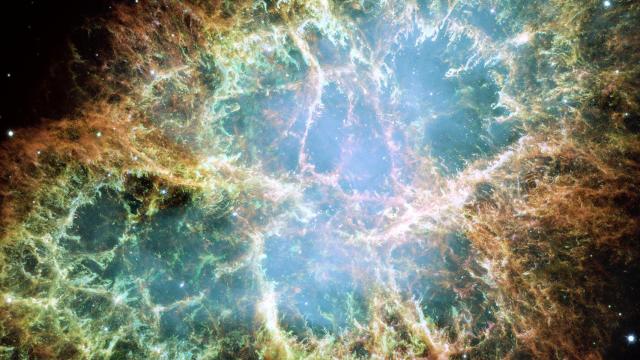A telescope in Tibet consisting of plastic detectors and underground water vat observed the highest-energy light yet – and it came from one of the most famous light sources in the sky.
For the first time, a team of scientists from 28 institutions across China, Tibet, and Japan report having measured photons, particles of electromagnetic radiation, with more than 100 tera-electronvolts (TeV) of energy, or around the kinetic energy of a flying bumble bee (an incredible amount, considering that we’re talking about individual light particles here!).
The source, the Crab Nebula, is a spinning neutron star that has continued to wow astrophysicists with its incredible physical properties. Discoveries like this can potentially open a window to the kinds of physical processes difficult to access in Earth-bound laboratories.
The experiment that discovered the light uses a familiar high-energy astronomy tool: an array of high-altitude detectors. This one consists of two parts, and is located in Yangbajain in Tibet at over 4267.20m above sea level.
On the ground is the Tibet AS array, 597 plastic detectors covering an area of 65,700 square meters. Buried beneath those detectors is the Tibet MD array, 64 vats each holding around 79,494l of liquid water. Particles travel at light speed (or nearly light speed) until they hit the detectors, whose sensing material has a slower top speed for light than a vacuum or air does. This creates a small flash akin to a shock wave but for light, which is detectable with the light-sensing equipment.
After more than three years of observation, the team took enough data and understood potential noise in the detector well enough to determine that they were seeing lots of high-energy light coming from the Crab Nebula.
This included 24 events that looked like photons and had energies higher than 100 TeV, including two candidate events with around 450 TeV of energy, according to the paper accepted for publication in Physical Review Letters.
How do they know where the light came from? The paths of particles like electrons, protons, and neutrons bend in the galaxy’s magnetic fields, so it’s hard to be sure of their source. But photons don’t change direction in these fields, so you can just trace the direction from which they arrived in the detector back to the source.
These aren’t the highest-energy particles ever discovered – some other detectors have measured interstellar protons and atomic nuclei with baffling energies. But this would be a record for photons.
The Crab Nebula is the remnant of a supernova recorded by Chinese astronomers in 1054 CE, and is today a cloud of gas and dust with a regularly spinning neutron star in the center, the Crab Pulsar, around 6500 light-years away.
This object is widely studied thanks to interest in spinning pulsars and their behaviour and the fact that it’s a supernova remnant whose source we know about. Now, researchers have confirmed it’s also a source of the highest-energy light observed here on Earth.
The researchers explain that this process is likely from inverse Compton scattering, or electrons travelling at nearly light speed near the pulsar interacting with and transferring energy to the photons, which we then observe on Earth.
This research continues to help scientists understand the wild processes that occur throughout our universe. Perhaps the researchers will one day observe the first peta-electronvolt light.
